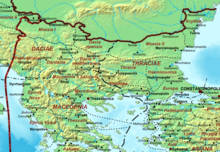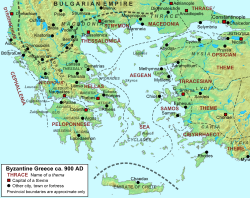Epirus (Roman province)
| Provincia Epiri Ἐπαρχία Ἠπείρου | |||||||||||||
|---|---|---|---|---|---|---|---|---|---|---|---|---|---|
| Province of the Roman Empire | |||||||||||||
| 100s or 110s AD–7th century | |||||||||||||
 The province of Epirus within the Roman Empire, c. 125 AD | |||||||||||||
| Capital | Nicopolis | ||||||||||||
| Historical era | Antiquity | ||||||||||||
• Established | 100s or 110s AD | ||||||||||||
• Balkans invaded by Slavs | 7th century | ||||||||||||
| |||||||||||||
| Today part of | Greece Albania | ||||||||||||
The province of Epirus (
History
Rome had maintained a military presence in Epirus since the First Macedonian War, when it used Epirus as an entry-point for Roman troops in Greece. Rome would continue to use Epirus as a gateway for its troops in the Second and Third Macedonian Wars. During the third war, the hitherto neutral Epirote League split, with the Molossians siding with the Macedonians and the Chaonians and Thesprotians supporting the Romans.[2] The war ended disastrously for Epirus: 150,000 Molossians were enslaved and the region fell to Rome.
The status of the region between 167 and 146 BC is unclear, but in 146 BC, it was grouped in the larger
Augustus also separated Epirus and Achaea from Macedonia in 27 BC, but it remained part of the province of Achaia until sometime between 104 and 117 AD, when Trajan made it a province in its own right.[1]
Epirus Vetus and Epirus Nova

Sometime during the provincial reorganization by
Late Antiquity
The two Epirote provinces became part of the
From 467 on, the Ionian Islands and the coasts of Epirus became subject to raids by the
In 517, a raid of the
Loss and Byzantine reconquest

In the late 6th century, much of Greece, including Epirus, fell under the control of the
The restoration of Byzantine rule seems to have proceeded from the islands, chiefly Cephallonia, which was certainly under firm Imperial control in c. 702, when
In about the middle of the 8th century, the
Economy
The province, especially the northern towns, benefitted greatly from the construction of the
Epirus also had significant populations of Italian settlers with large estates, attracted by the potential for pastoral agriculture. It is possible that these settlers had significant impact on the demographics and commerce of the province.[19]
Cities and settlements
The Synecdemus of Hierocles, composed in ca. 527–8 AD but probably reflecting the situation in the first half of the 5th century, reports eleven cities for Old Epirus:
- Nicopolis, the capital
- Dodona
- Euroea
- Hadrianopolis
- Appon
- Phoenice
- Anchiasmos
- Buthrotum
- Photike
- Corfu Island
- Ithaca Island.
New Epirus, with its capital at
Gallery
-
Roman theatre of Butrint
-
Roman amphitheatre of Dyrrachium
-
Early Christian basilica, Butrint
-
Roman nymphaeum, Nicopolis
-
A bastion of Durrës Castle, built by Emperor Anastasius I Dicorus
-
Mosaic from the Roman Villa of Manius Antoninus, Nicopolis
References
- ^ a b c d Soustal & Koder 1981, p. 47.
- ^ "Epirus". Encyclopædia Britannica. Encyclopædia Britannica, Inc. Retrieved 16 November 2013.
- ^ Walker & Wilkes 2010, p. 212.
- ISBN 978-1-84217-158-5. Retrieved 8 January 2011.
- ISBN 9789602133712.
"At Bouthrotos, it is enough to compare the theatre, built of grey poros, with all the Roman structures surrounding it: the skene and the neighbouring buildings, the new sanctuary of Asklepios and the areas next to it
- ^ Soustal & Koder 1981, pp. 47–48.
- ^ a b c d Soustal & Koder 1981, p. 48.
- ^ a b c d Soustal & Koder 1981, p. 49.
- ^ Wolfram 1988, pp. 271–274.
- ^ a b Soustal & Koder 1981, p. 50.
- ^ Soustal & Koder 1981, p. 51.
- ^ Soustal & Koder 1981, p. 52.
- ^ Soustal & Koder 1981, p. 53.
- ^ Nesbitt & Oikonomides 1991, p. 40.
- ^ ODB, "Dyrrachion", (T. E. Gregory), p. 668.
- ^ Pertusi 1952, p. 177.
- ^ Walker & Wilkes 2010, p. 204.
- ^ Eberle & le Quéré 2017, p. 41.
- ^ Eberle & le Quéré 2017, pp. 40–42.
- ^ Soustal & Koder 1981, pp. 48–49.
Sources
- Soustal, Peter; Koder, Johannes (1981). Tabula Imperii Byzantini, Band 3: Nikopolis und Kephallēnia (in German). Vienna: ISBN 978-3-7001-0399-8.
- Eberle, Lisa Pilar; le Quéré, Enora (2017). "Landed Traders, Trading Agriculturalists? Land in the Economy of the Italian Diaspora in the Greek East". Journal of Roman Studies: 107, 27–59. JSTOR 26576044.
- Walker, Susan; Wilkes, John (2010). "Becoming Roman and staying Greek in the Southern Adriatic". Bulletin of the Institute of Classical Studies: 197–212. JSTOR 44214907.
- ISBN 0-19-504652-8.
- Nesbitt, John; ISBN 0-88402-194-7.
- Pertusi, A. (1952). Constantino Porfirogenito: De Thematibus (in Italian). Rome: Biblioteca Apostolica Vaticana.
- Wolfram, Herwig (1988). History of the Goths. Berkeley and Los Angeles: University of California Press. ISBN 978-0-52006-983-1.







